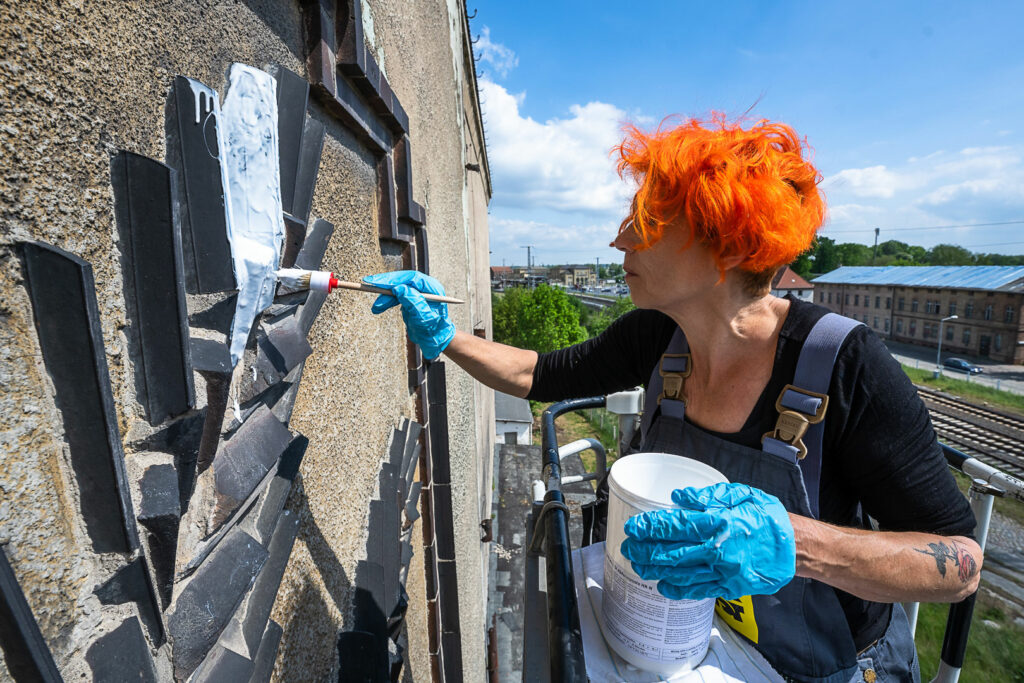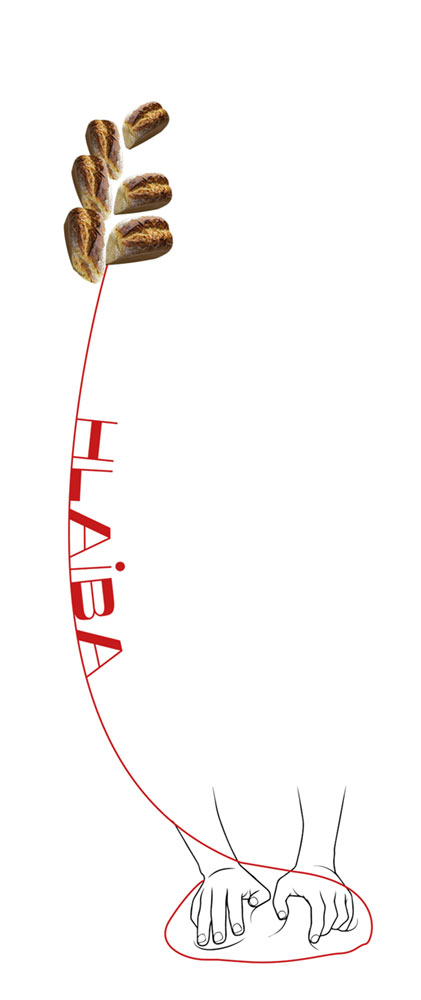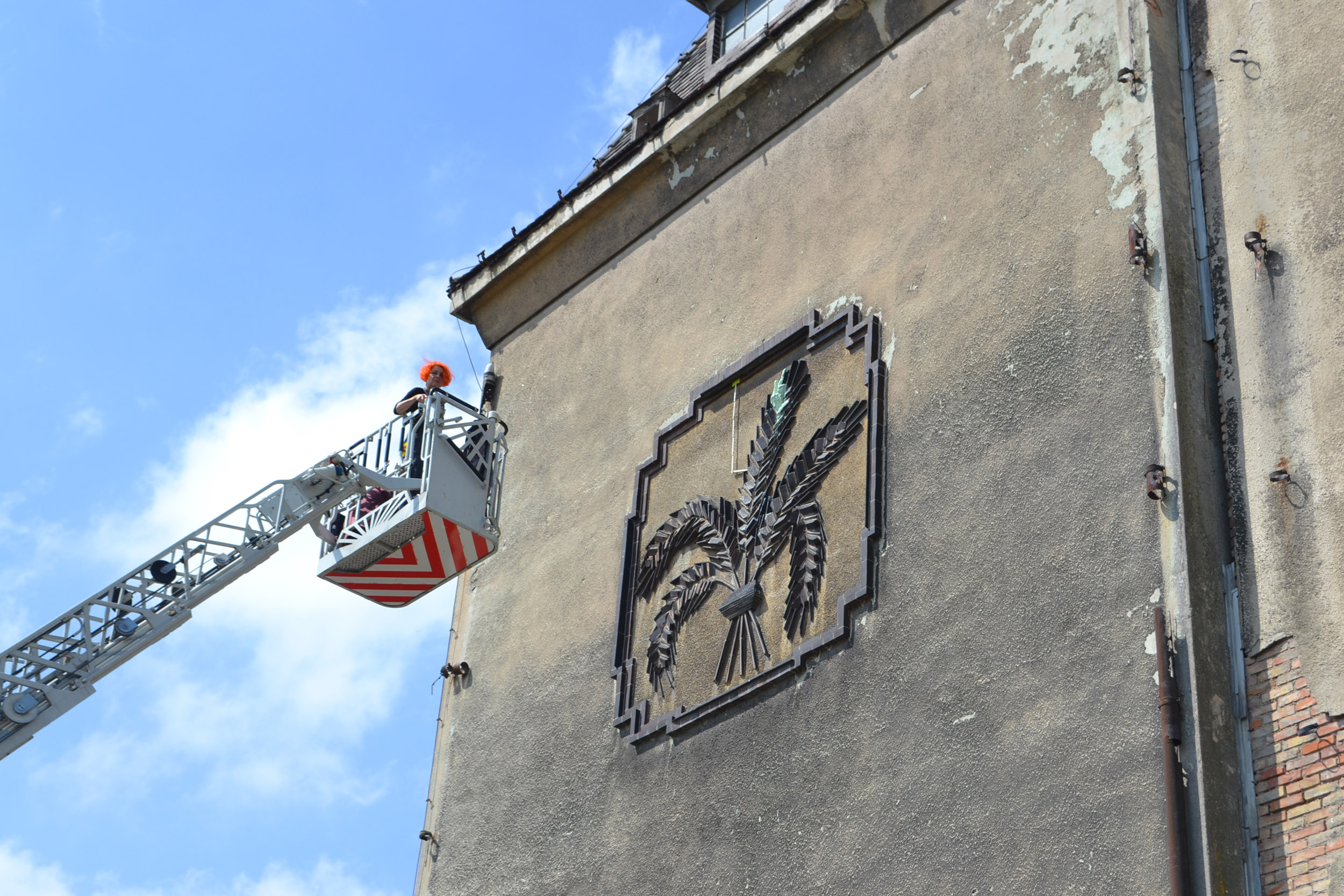The artistic work HLAIBA (from ancient engl. hlaf “loaf bread”) addresses how livelihoods are not only destroyed by tanks and howitzers in wartime, but how hunger has always been created as an existentially destructive, power-political instrument of warfare.
The starting point for the social bread work is an ear relief from the 1930s on a former granary in the town of Pasewalk in Mecklenburg/ Western Pomerania – a façade drawing made of brick and beaver tail that recalls Pasewalk as an agrarian town (Ackerbürgerstadt) and refers to the region’s importance as an agricultural location – until after the fall of the Wall.
The five ears of grain in the relief will be recreated from 144 loaves of bread in a collaborative act by SCHRIFTT:MACHERINNEN barbara caveng and Lana Svirezheva together with residents of Pasewalk and the surrounding area, and presented by the Ladies Hlaiba* in a ceremony on July 23 and 24 at NUR KUNST in Große Kirchstraße 25/ Piazza Pasenelle.
The individual loaves can be purchased for donations. The proceeds will benefit people in difficult life situations.
All humans in the region are cordially invited to bake a loaf of bread for the work, which is dedicated to life in a community of solidarity.
In close vicinity of the warehouse building rises a mighty silo, a white 80,000 ton grain palace built by VEB Fortschritt, relic of flourishing agricultural economy and landmark of the city. Up to 400 tons of grain per hour were proceeded at VEB Getreidewirtschaft Pasewalk in GDR times. After reunification, the former nationally owned enterprise (VEB) became the property of the HaGe Group and is now of little significance to the world of work in local people’s lives. The silo silhouette remains as life casted in concrete, memory stored in eight tubes. The majority of flour mills in the region have also long since stood still, transformed into museums or restaurants.

former grannary (c)barbara caveng 
in touch (c)Lana Svirezheva 
(c)Stefan Schwill 
Silo of Pasewalk
“Bread is the head of everything” – Ukrainian proverb
20 million tons of grain are stored in Ukrainian granaries, the media report. Enough to save the world from what is now looming: a famine that will drastically exacerbate the existing plight of millions who do not have enough to eat. Yemen, Chad, Somalia, Lebanon…. Every day, more countries come into focus whose inhabitants are threatened by starvation.
Holodomor – death by starvation for economic interests – between 3 and 7 million* people starved to death during the forced industrialization of agriculture carried out by the Soviet Union in the Ukrainian Soviet Republic in the 1930s. The bouquet of five ears of corn evokes different assosiactions: “We remember the Holodomor and the infamous ‘law of five ears of corn’ . This law became a harbinger of the Holodomor. It provided for the theft of collective farm property by execution on the spot and confiscation of the property. This is shocking, but even a few spikelets wintering in the field under the snow were considered such property.” Words of Maryna Bielinska, psychologist from Kiev, on 23.5.2022 in a written exchange about the project ‘Hlaiba’.
In the collection “Contributions to the History of Pasewalk” from 1988 there is a poem by Elisabeth Haase. It reads as if she had just written it…..

BROTAUTOS AUF DER RAMPE
Sie warten
auf die kostbare Fracht dieser Erde
Brot.
Erfleht durch Jahrtausende.
Vorhanden nie ausreichend.
Gefährdet immer,
noch nie so wie heute,
das Brot.
Sein Duft
weckt Erinnerung an Sommer voll Reife
und Kindheit. An Hände der Mutter,
freigebig nicht nur mit Brot.
Sie warten
auf die kostbare Fracht dieser Erde.
Solange sie fahren
ist Frieden.
**Ladies HLAIBA refers to the original meaning of the word read in the Wahrig Dictionary:
*Lady in England: Title for noble woman, also general. : Lady
Engl. lady, from middle engl. lafdi, lavede, from ancient engl. hlæfdige “Housewife”, respectively breadmaker (Brotmacherin), from ancient English. hlaf “loaf bread” (to goth. hlaifs, ancient nordic. hleifr “loaf bread”) and old nordic. dige “maid” (who is responsible for making dough, to get. digan “knead”)

